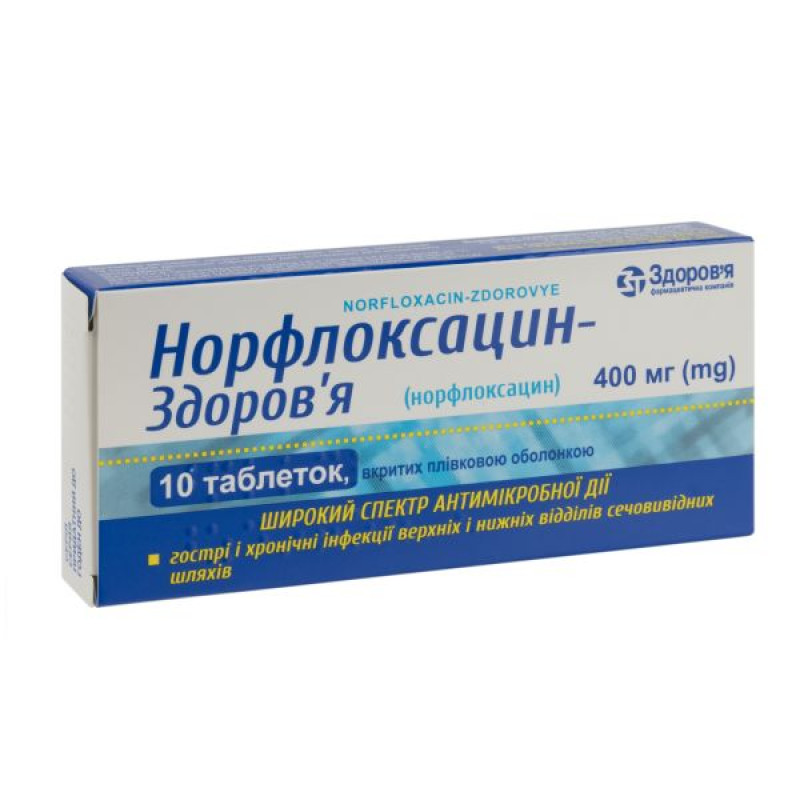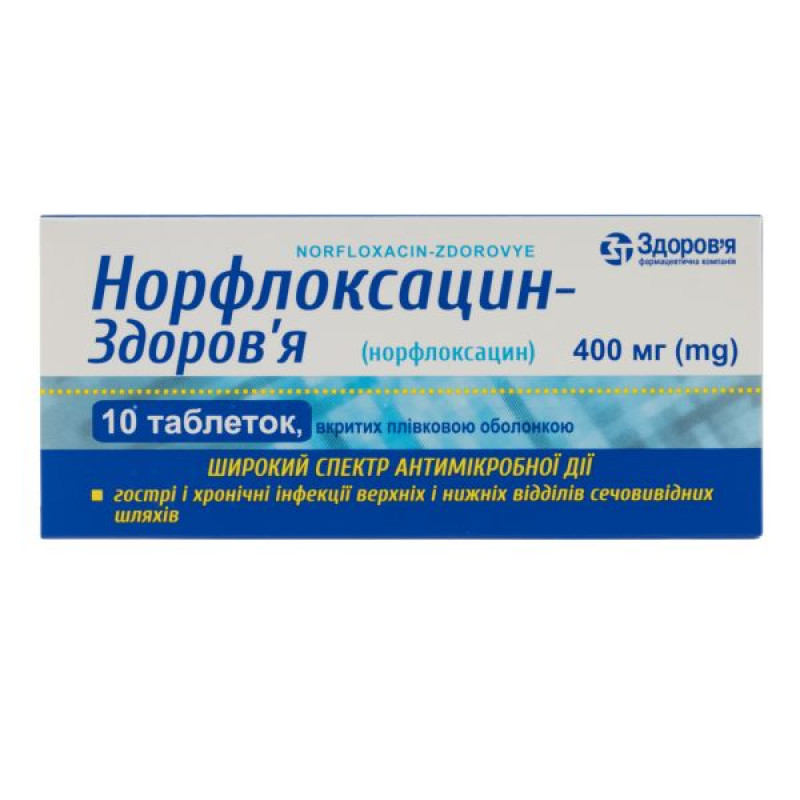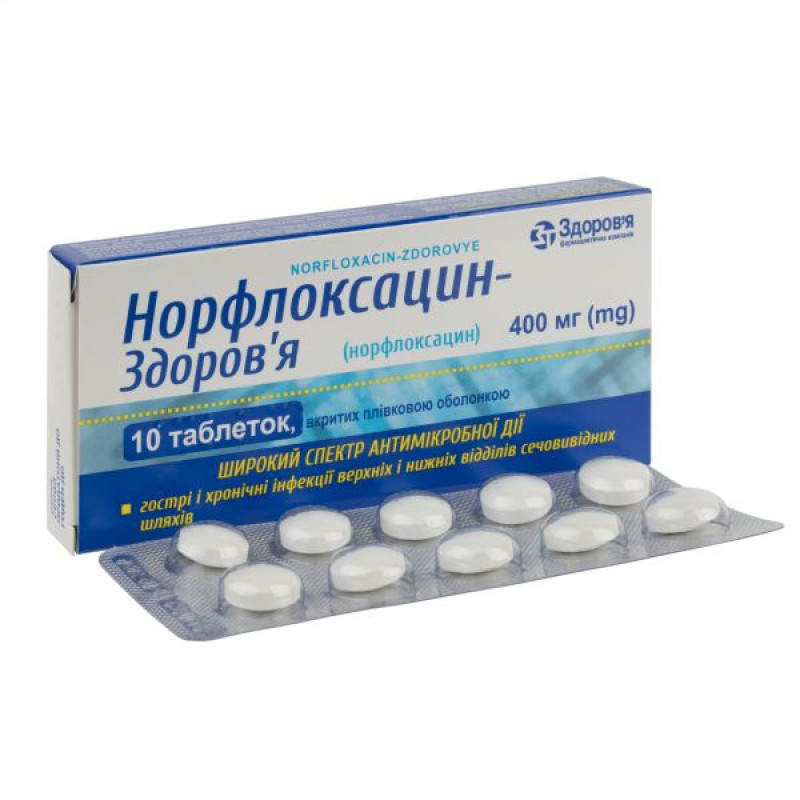Norfloxacin-Health film-coated tablets 400 mg blister No. 10

Instructions Norfloxacin-Health film-coated tablets 400 mg blister No. 10
Composition
active ingredient: norfloxacin;
1 tablet contains norfloxacin 400 mg;
Excipients: microcrystalline cellulose; croscarmellose sodium; potato starch; crospovidone; calcium hydrogen phosphate; talc; calcium stearate; hypromellose; copovidone; lactose monohydrate; polyethylene glycol 4000; titanium dioxide (E 171).
Dosage form
Film-coated tablets.
Main physicochemical properties: film-coated tablets, white to white with a yellowish tinge. Two layers are visible on cross-section.
Pharmacotherapeutic group
Antimicrobial agents for systemic use. Antibacterial agents of the quinolone group. Norfloxacin. ATX code J01M A06.
Pharmacological properties
Pharmacodynamics
A synthetic antibacterial drug of the fluoroquinolone family with a broad spectrum of antimicrobial activity.
The mechanism of action is due to inhibition of bacterial deoxyribonucleic acid (DNA) synthesis by affecting the DNA gyrase enzyme.
The main part of the spectrum of action of norfloxacin is its effect on Neisseria gonorrhoeae (including penicillinase-producing strains).
Norfloxacin is usually effective against pathogens that cause urinary tract infections, such as Escherichia coli, Enterobacter spp., Klebsiella, Proteus spp., Pseudomonas aeruginosa, and Serratia marcescens. Norfloxacin may also be effective against pathogens that cause inflammation of the small intestine, such as Escherichia coli, Salmonella enteritis, and Campylobacter spp.
Norfloxacin is moderately active against selected strains of Ureaplasma urealyticum. Higher levels of resistance are expected against Enterococcus faecalis and Enterococcus faecium.
Norfloxacin is ineffective against obligate anaerobic pathogens such as Actinomyces spp., Bacteroides spp., Clostridium spp. (except for certain strains of C. perfringens) and Peptostreptococcus spp., as well as against Stenotrophomonas maltophilia and Chlamidia trachomatis. There is partial cross-resistance of norfloxacin with other fluoroquinolones. There is no cross-resistance with structurally unrelated drugs such as penicillins, cephalosporins, tetracyclines, macrolide antibiotics, aminoglycosides, sulfonamides and 2,4-dihydropyrimidines or combinations of these substances (e.g. co-trimoxazole).
Methicillin-resistant staphylococci are mostly resistant to fluoroquinolones.
Pharmacokinetics
Norfloxacin is rapidly absorbed from the gastrointestinal tract after oral administration, with an absolute bioavailability of 30–40%. Food intake slows down absorption. Peak plasma concentrations are reached within 1–2 hours after administration. T½ of norfloxacin is almost 4 hours, and may be increased in patients with renal insufficiency. Approximately 14% of the administered dose binds to plasma proteins. Norfloxacin reaches high concentrations in the tissues of the urogenital tract, urine, and bile. Almost 30% of the administered dose is excreted unchanged in the urine within 24 hours. Approximately 30% of the administered dose of norfloxacin is excreted through the gastrointestinal tract.
Indication
Uncomplicated acute cystitis - only if the use of other antibacterial agents that are usually prescribed to treat this infection is considered ineffective or inappropriate.
Urethritis, particularly caused by susceptible strains of Neisseria gonorrhoeae.
Complicated urinary tract infections (except complicated pyelonephritis).
Complicated acute cystitis.
Uncomplicated acute pyelonephritis.
Prevention of bacterial infections in patients with neutropenia.
Official recommendations on the appropriate use of antibacterial drugs should be taken into account.
Contraindication
Hypersensitivity to the components of the drug/quinolone derivatives.
History of tendinitis or tendon ruptures associated with treatment with quinolone derivatives.
Interaction with other medicinal products and other types of interactions
Norfloxacin inhibits the CYP1A2 isoenzyme, which may lead to interactions with other drugs that are metabolized by this isoenzyme.
Nitrofurantoin: Antagonism between norfloxacin and nitrofurantoin has been shown in vitro, therefore their concomitant use should be avoided.
Probenecid: Probenecid reduces the urinary excretion of norfloxacin but does not affect its normal serum concentration.
Theophylline. It is possible to increase the level of theophylline in the blood plasma of patients when it is used simultaneously with norfloxacin, as well as to increase the development of side effects caused by norfloxacin. Therefore, when using norfloxacin and theophylline simultaneously, it is necessary to monitor the concentration of theophylline in the blood plasma and, if necessary, adjust the dosage.
Cyclosporine: Concomitant use with norfloxacin may increase the serum concentration of cyclosporine. Therefore, the serum concentration of cyclosporine should be monitored and, if necessary, the dosage adjusted accordingly.
Warfarin. Norfloxacin, like other quinolones, may potentiate the effects of the oral anticoagulant warfarin or its derivatives (e.g., phenprocoumon, acenocoumarol), therefore, when these drugs are used concomitantly, prothrombin time or other coagulation parameters should be carefully monitored.
Hormonal contraceptives. The contraceptive effect of oral contraceptives may in rare cases be questioned during treatment with antibiotics, therefore, when using norfloxacin and oral contraceptives simultaneously, the use of non-hormonal contraceptive methods is additionally recommended.
Fenbufen. It has been experimentally proven that the simultaneous use of quinolones with fenbufen can cause epileptic seizures, therefore, the use of quinolones together with fenbufen should be avoided.
Clozapine, ropinirole: If norfloxacin is started or stopped, the dose of clozapine or ropinirole may need to be adjusted for patients already taking these drugs.
Tizanidine. Concomitant administration of tizanidine and norfloxacin is not recommended.
Glibenclamide: Concomitant administration of quinolones, including norfloxacin, with glibenclamide (a sulfonylurea derivative) may cause severe hypoglycemia. Therefore, monitoring of blood glucose levels is recommended when these drugs are administered concomitantly.
Didanosine: Drugs containing didanosine should not be taken with norfloxacin or within 2 hours of taking norfloxacin because these drugs may interfere with each other's absorption, resulting in low norfloxacin serum and urine concentrations.
Nonsteroidal anti-inflammatory drugs (NSAIDs). Concomitant use of NSAIDs with quinolones, including norfloxacin, may increase the risk of central nervous system stimulation and convulsions. Therefore, norfloxacin should be used with caution in individuals taking NSAIDs concomitantly.
Various medications (iron preparations, antacids and preparations containing magnesium, aluminum, calcium and zinc). Calcium preparations, multivitamin preparations containing calcium should not be used together with norfloxacin, as there may be a decrease in the absorption of norfloxacin, leading to a decrease in its concentration in the blood serum and urine. This also applies to nutritional solutions administered orally and most dairy products (milk or natural dairy products such as yogurt).
Application features
Norfloxacin should be avoided in patients who have experienced serious adverse reactions in the past with quinolones or fluoroquinolones. Norfloxacin should only be initiated in these patients when no alternative treatment options are available and after a careful benefit/risk assessment.
When using the drug, as well as other drugs of the quinolone group, increased photosensitivity is possible, therefore, during treatment, prolonged and strong exposure to sunlight should be avoided. During this period, you should also not use a solarium. If signs of photosensitivity appear, treatment should be discontinued.
Tendinitis and tendon rupture. With norfloxacin, as with other quinolones, cases of tendinitis and/or tendon rupture (especially but not limited to the Achilles tendon), sometimes bilateral, may occur within 48 hours of starting treatment with quinolones and fluoroquinolones and have been reported to occur up to several months after stopping treatment. The risk of tendinitis and tendon rupture is increased in elderly patients, patients with impaired renal function, patients with organ transplants and patients receiving treatment with corticosteroids. Therefore, concomitant use of corticosteroids should be avoided. At the first sign of tendinitis (e.g. painful swelling, inflammation), norfloxacin should be discontinued and alternative treatment considered. Appropriate therapy of the affected limb (e.g. immobilization) and consultation with a physician are necessary.
The drug should be used only when there is an overwhelming clinical need in patients with known epilepsy or diseases that lower the seizure threshold. Convulsions have been reported in rare cases in patients receiving norfloxacin. Norfloxacin may lead to exacerbation and deepening of symptoms in patients with known or suspected psychiatric disorders, hallucinations and/or confusion. In the event of seizures, treatment with norfloxacin should be discontinued.
When using the drug, myasthenia gravis (undiagnosed before starting treatment) may occur, which can cause life-threatening respiratory muscle failure.
If shortness of breath occurs during treatment with norfloxacin, appropriate emergency measures should be taken.
Very rarely, some quinolones may cause prolongation of the QT interval on the electrocardiogram and infrequent cases of arrhythmia (including extremely rare cases of ventricular fibrillation). As with other drugs that may prolong the QT interval, norfloxacin should be used with caution in patients with uncorrected electrolyte imbalance (e.g. hypokalemia, hypomagnesemia), cardiac disease (e.g. heart failure, myocardial infarction, bradycardia), congenital long QT syndrome, or patients receiving concomitant treatment with class Ia or III antiarrhythmics.
Some quinolones, including norfloxacin, should be used with caution in patients taking cisapride, macrolides, antipsychotics, tricyclic antidepressants, or who have a personal or family history of QT prolongation.
Elderly patients and women may be more sensitive to drugs that prolong the QT interval. Therefore, caution should be exercised when using fluoroquinolones, including norfloxacin, in these populations.
In patients with severe renal impairment, the risk/benefit ratio of norfloxacin should be carefully weighed for the patient. Urinary concentrations of norfloxacin may be reduced in patients with severe renal impairment, as norfloxacin is primarily excreted by the kidneys.
In case of prolonged treatment, the occurrence of crystalluria should be monitored. Although crystalluria is not expected under normal conditions with a dosage regimen of 400 mg twice daily, as a precautionary measure, the recommended daily dose should not be exceeded and sufficient fluid intake should be ensured to ensure proper hydration and adequate urinary function.
The occurrence of severe and prolonged diarrhea during or after therapy may be evidence of pseudomembranous colitis, which has been observed very rarely. In such cases, the drug should be discontinued immediately and appropriate therapy should be initiated (e.g., vancomycin, 4x250 mg orally). Drugs that inhibit peristalsis are contraindicated.
Cholestatic hepatitis has been commonly reported with norfloxacin treatment. Patients should be advised to discontinue treatment and seek medical attention if signs and symptoms of liver disease develop, such as anorexia, jaundice, dark urine, pruritus, or abdominal pain on exertion.
Aortic aneurysm and dissection and heart valve regurgitation/insufficiency. There is evidence of an increased risk of aortic aneurysm and dissection, particularly in the elderly, and of aortic and mitral valve regurgitation following the use of fluoroquinolones. Cases of aortic aneurysm and dissection, sometimes complicated by rupture (including fatal cases), and of regurgitation/insufficiency of any of the heart valves have been reported in patients receiving fluoroquinolones (see section 4.8).
Therefore, fluoroquinolones should only be used after careful benefit-risk assessment and after consideration of other treatment options in patients with a family history of aneurysm or congenital heart valve disease, or in patients with a diagnosis of aortic aneurysm and/or aortic dissection, or with heart valve disease, or in the presence of other risk factors or predisposing conditions.
both for aortic aneurysm and dissection, and for heart valve regurgitation/insufficiency (e.g. connective tissue diseases such as Marfan syndrome or Ehlers-Danlos syndrome, Turner syndrome, Behçet's disease, arterial hypertension, rheumatoid arthritis) or additionally
for aortic aneurysm and dissection (e.g. vascular disorders such as Takayasu arteritis or giant cell arteritis, or known atherosclerosis, or Sjögren's syndrome) or additionally
for regurgitation/valve insufficiency (e.g., infective endocarditis). The risk of aortic aneurysm and dissection and rupture may be increased in patients receiving concomitant systemic corticosteroids.
In case of sudden abdominal, chest or back pain, patients should seek immediate medical attention in the emergency department.
Patients should be advised to seek immediate medical attention in the event of acute dyspnea, new onset of palpitations, or development of abdominal or lower extremity edema.
This medicinal product contains lactose. If you have been told by your doctor that you have an intolerance to some sugars, contact your doctor before taking this medicinal product.
Norfloxacin should be taken 2 hours before or 4 hours after calcium supplements, multivitamins containing calcium, oral nutritional solutions, and dairy products.
Norfloxacin should be discontinued immediately at the first signs or symptoms of any serious adverse reaction, and patients should be advised to seek medical advice.
Peripheral Neuropathy: Cases of sensory or sensorimotor polyneuropathy resulting in paresthesia, hypoesthesia, dysesthesia, or weakness have been reported in patients treated with quinolones and fluoroquinolones. Patients taking norfloxacin should inform their physician before continuing treatment if they develop symptoms of neuropathy such as pain, burning, tingling, numbness, or weakness to prevent the development of a potentially irreversible condition.
Use during pregnancy or breastfeeding
The drug is contraindicated for use during pregnancy. Norfloxacin, like other quinolones, penetrates into breast milk, so if necessary, use of the drug should be discontinued breastfeeding.
Ability to influence reaction speed when driving vehicles or other mechanisms
During treatment with the drug, you should refrain from driving or operating other mechanisms.
Method of administration and doses
To be administered to adults on an empty stomach, with water, or during meals. The drug is best taken 2 times a day (morning and evening), but can be taken once a day (at the same time).
The dosage depends on the sensitivity of the pathogenic microorganisms and the severity of the disease, therefore, before starting treatment, it is necessary to check the sensitivity of the pathogenic microorganism to norfloxacin. However, treatment can be started before the results of sensitivity studies are available. In this case, before starting the planned therapy, it is necessary to take material for laboratory diagnostics in order to be able to change the treatment in case of the absence of sensitivity of the pathogens to norfloxacin.
Dosage
| Diagnosis | Dosage | Duration application |
| Uncomplicated acute cystitis | 1 tablet (400 mg) 2 times a day | 3 days |
Urethritis, particularly caused by susceptible strains of Neisseria gonorrhoeae. Uncomplicated acute pyelonephritis. | 1 tablet (400 mg) 2 times a day | 7–10 days* |
Complicated urinary tract infections (except complicated pyelonephritis). Complicated acute cystitis. | 1 tablet (400 mg) 2 times a day | 2–3 weeks* |
| Prevention of bacterial infections in patients with neutropenia. | 1 tablet (400 mg) 2–3 times a day | The entire period neutropenia** |
*Some symptoms of urinary tract infection (burning during urination, fever, pain) resolve within 1–2 days, but treatment should be continued as recommended.
**Data on treatment duration beyond 8 weeks are not yet available.
Dosage for patients with renal insufficiency. The drug can be used in patients with renal insufficiency. With creatinine clearance less than or equal to 30 ml/min, the recommended dose of the drug should not exceed 1 tablet (400 mg) per day.
Dosage for elderly patients. In the absence of renal insufficiency, there is no need to adjust the dose of the drug.
Children
The drug is contraindicated for use in children.
Overdose
Symptoms: fever, shortness of breath, fever, leukopenia, thrombocytopenia, acute hemolytic anemia, allergic reactions, gastrointestinal disorders, renal failure.
Treatment: In case of acute overdose, the patient should immediately drink a solution containing calcium to convert norfloxacin into a complex with calcium, which is absorbed from the gastrointestinal tract in very small quantities. The patient should be carefully examined and, if necessary, symptomatic supportive treatment should be prescribed. Adequate fluid replacement should be ensured.
Side effects
Cardiovascular system**: tachycardia, arrhythmia; very rarely, when taking some quinolone drugs, including norfloxacin, prolonged QT interval and ventricular arrhythmia (including torsades de pointes); decreased blood pressure, fainting, vasculitis.
From the blood and lymphatic system: leukopenia, eosinophilia, neutropenia, decreased hematocrit, hemolytic anemia, thrombocytopenia.
Nervous system*: headache, drowsiness, hallucinations, increased fatigue, mood changes, paresthesias, disorientation, polyneuropathy, including Guillain-Barré syndrome, epileptiform seizures, hypoesthesia, tremor, myoclonus.
Psychiatric disorders*: insomnia, depression, anxiety, irritability, euphoria, confusion, psychotic reactions.
Gastrointestinal tract: anorexia, bitter taste in the mouth, nausea, vomiting, abdominal pain, diarrhea, pseudomembranous enterocolitis (with prolonged use), moderate gastralgia, heartburn, pancreatitis.
From the urinary system: crystalluria, glomerulonephritis, interstitial nephritis, dysuria, polyuria, albuminuria, urethral bleeding, hypercreatininemia.
Musculoskeletal and connective tissue disorders*: arthralgia, tendinitis, tendovaginitis, tendon rupture, myalgia, arthritis. Very rare: Achilles tendonitis, which may lead to Achilles tendon rupture.
On the part of the immune system: hypersensitivity reactions, urticaria, anaphylaxis, angioedema; in rare cases - exfoliative dermatitis, Stevens-Johnson syndrome, Lyell's syndrome, exudative polymorphic erythema, photosensitization.
From the hepatobiliary system: hepatitis, increased activity of hepatic transaminases, jaundice.
From the organs of vision*: dysopia, increased lacrimation.
From the side of the organs of hearing and labyrinth*: dizziness, tinnitus, hearing loss.
Changes in laboratory parameters: increased levels of glutamate-oxaloacetate transaminase, glutamate-pyruvate transaminase and serum alkaline phosphatase.
Others: vaginal candidiasis, shortness of breath, dysgeusia.
* Very rare cases of prolonged (up to months or years) disabling and potentially irreversible serious adverse reactions affecting various, sometimes multiple, body systems (including reactions such as tendinitis, tendon rupture, arthralgia, pain in extremities, gait disturbance, neuropathies associated with paraesthesia, depression, fatigue, memory impairment, sleep disturbances, hearing, vision, taste and smell disturbances) have been reported in association with the use of quinolones and fluoroquinolones in some cases, regardless of the underlying risk factors.
** Cases of aortic aneurysm and dissection, sometimes complicated by rupture (including fatal cases), and regurgitation/insufficiency of any of the heart valves have been reported in patients receiving fluoroquinolones (see section 4.4).
Pseudomembranous colitis: If pseudomembranous colitis occurs, the physician should consider discontinuing norfloxacin treatment, as indicated, and immediately initiate appropriate treatment for the adverse reaction (e.g., appropriate antibiotics/chemotherapeutic agents with clinically proven efficacy). Medicinal products that inhibit peristalsis should not be used.
Severe hypersensitivity reactions (e.g. anaphylaxis). If such reactions occur, treatment with norfloxacin should be discontinued immediately and appropriate emergency measures should be taken (e.g. administration of antihistamines, corticosteroids, sympathomimetics, and, if necessary, artificial ventilation of the lungs).
Occurrence of epileptiform seizures. In such cases, the usual appropriate emergency measures should be taken (e.g. maintaining a clear airway, administration of anticonvulsants, in particular diazepam or barbiturates).
Expiration date
3 years.
Storage conditions
Store in the original packaging at a temperature not exceeding 25 °C.
Keep out of reach of children.
Packaging
Tablets No. 10 in a blister in a box.
Vacation category
According to the recipe.
Producer
Limited Liability Company "Pharmaceutical Company "Zdorovya".
Limited Liability Company "PHARMEX GROUP".
Location of the manufacturer and address of the place of its activity. Ukraine, 61013, Kharkiv region, Kharkiv city, Shevchenko street, building 22.
(Limited Liability Company "Pharmaceutical Company "Zdorovya")
Ukraine, 08301, Kyiv region, Boryspil city, Shevchenko street, building 100.
(Limited Liability Company "PHARMEX GROUP")
There are no reviews for this product.
There are no reviews for this product, be the first to leave your review.
No questions about this product, be the first and ask your question.










